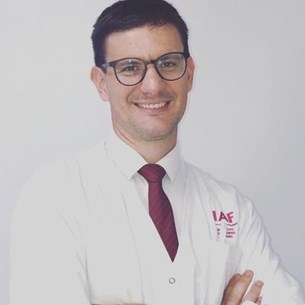Meeting
2024 ASCO Genitourinary Cancers Symposium

Alexander Fleming Institute, Buenos Aires, Argentina
Federico Losco , Martin Angel , Juan Pablo Sade , Adriana Verónica Vitriu , Tomás Soulé , Luis Ayala , Olivia Gelo , Jeremías Sierra , Mariano Berro , Martín Castro , Silvina Palmer , Ruben Burgos , Soledad Cruset , Gonzalo Ariel Ferini , Mariel Perez , Priscila Wernicke , Sofia Pelayes Tortosa , Patricio Duarte , Sebastián Yantorno , María Cecilia Foncuberta
Background: Germ cell tumors (GCTs) are the most common type of cancer in adolescent and young adult males. Most of them are curable with multimodal treatment: platinum-based chemotherapy (CT) + surgery. Patients who fail first-line treatment usually receive salvage CT with response rates between 30 and 50%. High-dose chemotherapy and autologous hematopoietic stem cell transplantation (HDCT) is an effective treatment in this context. Methods: We conducted a multicenter retrospective analysis of patients ≥ 15 years old with relapsed/refractory GCTs who received HDCT in 13 centers of the Argentine Group of Bone Marrow Transplantation and Cellular Therapy (GATMO-TC) from 2010 to 2022. Results: 114 patients were included, with a median age of 32 years (range: 15-58). Most had non-seminoma histology (66%); The primary tumor site was testis (65%), retroperitoneum (17%), and mediastinum (9%). Forty percent (n:46) had an unfavorable prognosis according to the IGCCCG score. Eighty-two % received ≥ 2 lines of CT before HDCT, 27% being platinum-refractory disease (PRD), and 45% received 2 consecutive courses of HDCT (tandem). All patients received a carboplatin-etoposide-based conditioning regimen. The median engraftment time was 12 days (d) (r8;25) for neutrophils and 15 d (r6;58) for platelets. Bacteremia (25%) and Hepatotoxicity (14.9%) were the most frequent G3-4 adverse events. With a median follow-up of 12.6 months (r1-138), 100 pts were evaluable for survival. 12- and 24-months OS was 67%- 64%; and PFS 56%; - 54% respectively. PRD patients had worse OS and PFS. Eighteen patients remained alive and without relapsing beyond 5 years of follow-up. Conclusions: This real-world multicentric study demonstrates that some patients with refractory/relapsed metastatic GCT are curable by HDCT, being an effective and safe feasible treatment with response rates similar to those described in the literature. The superiority of the tandem approach could not be demonstrated due to the heterogeneity of the sample.
| PFS % (CI 95%) | OS % (CI 95%) | |||||
|---|---|---|---|---|---|---|
| 12 months | 24 months | p-value | 12 months | 2p-values | p value | |
| CR (N:26) | 69 (43-84) | 62 (36-80) | 0,01 | 94 (65-99) | 79 (48-93) | 0,07 |
| PR (N:49) | 57 (41-70) | 57 (41-70) | 63 (46-76) | 63 (46-76) | ||
| PRD (N:25) | 39 (18-59) | 39 (18-59) | 54 (31-72) | 43 (21-63) | ||
CR: complete response; PR: partial response; PRD: platinum refractory disease.
Disclaimer
This material on this page is ©2024 American Society of Clinical Oncology, all rights reserved. Licensing available upon request. For more information, please contact licensing@asco.org
2024 ASCO Genitourinary Cancers Symposium
Poster Session
Poster Session C: Renal Cell Cancer; Adrenal, Penile, and Testicular Cancers
Renal Cell Cancer,Adrenal Cancer,Penile Cancer,Testicular Cancer
Quality of Care/Quality Improvement and Real-World Evidence
J Clin Oncol 42, 2024 (suppl 4; abstr 508)
10.1200/JCO.2024.42.4_suppl.508
508
L10
Abstract Disclosures
2022 ASCO Annual Meeting
First Author: Fadi Taza
2023 ASCO Annual Meeting
First Author: Samuel A Funt
2018 Genitourinary Cancers Symposium
First Author: Deepak Kilari
2024 ASCO Gastrointestinal Cancers Symposium
First Author: Kohei Shitara